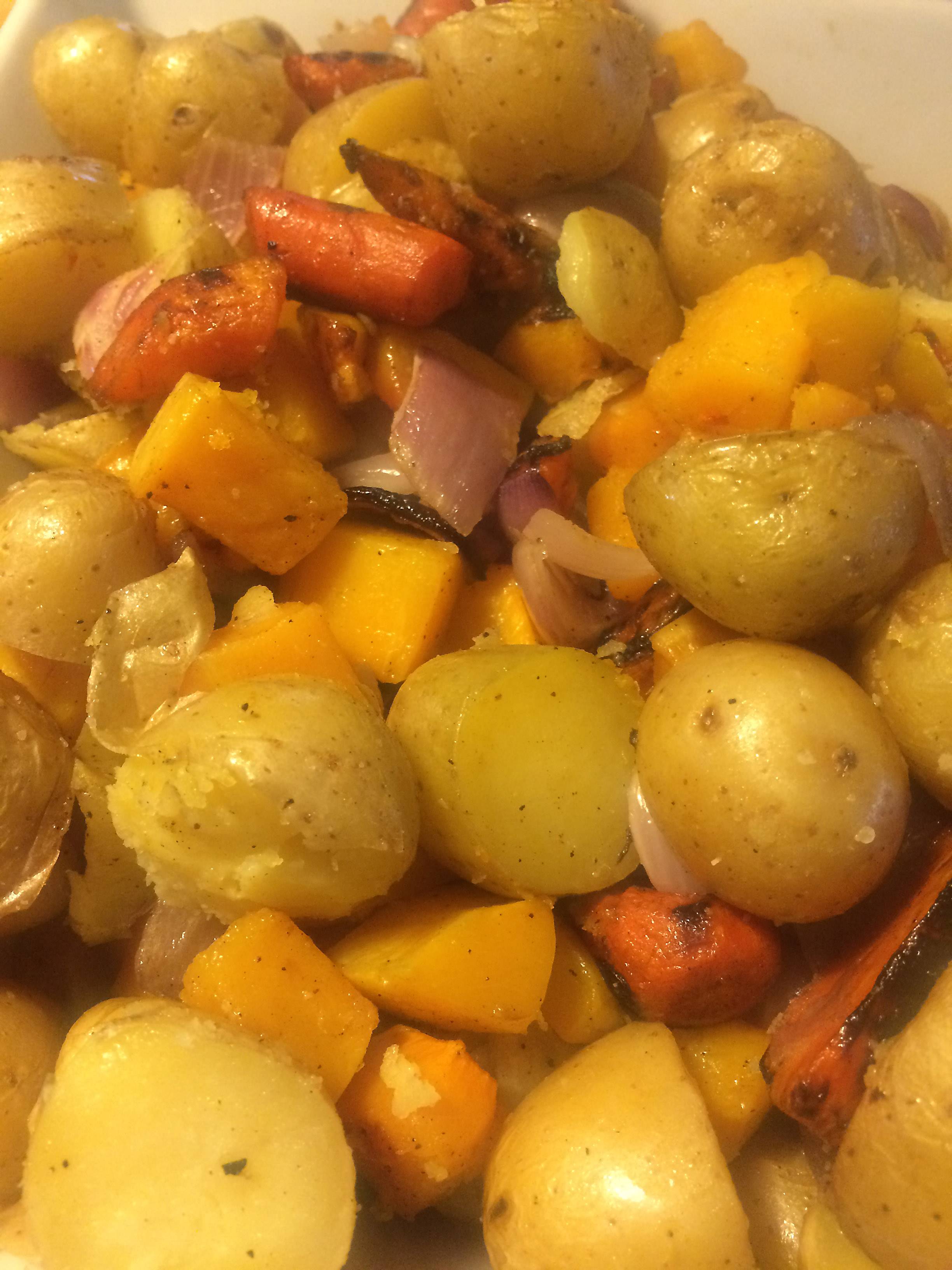Introduction
Since cooking for yourself is just about the healthiest thing going, you should do it more. But you don't have time, right? This is an easy side dish -- or main dish, if you so desire -- that is cheap, easy, and doesn't take much active time. It's just about the easiest way to prepare any vegetable.
This probably isn't your first place to look for recipes. And we're about design and craft, not a cooking show. But cooking involves craft, too, and it's the kind of craft that you can do yourself without a lot of special equipment. So do be sure to read the Theory section below even if you don't otherwise need any help roasting vegetables.
This probably isn't your first place to look for recipes. And we're about design and craft, not a cooking show. But cooking involves craft, too, and it's the kind of craft that you can do yourself without a lot of special equipment. So do be sure to read the Theory section below even if you don't otherwise need any help roasting vegetables.
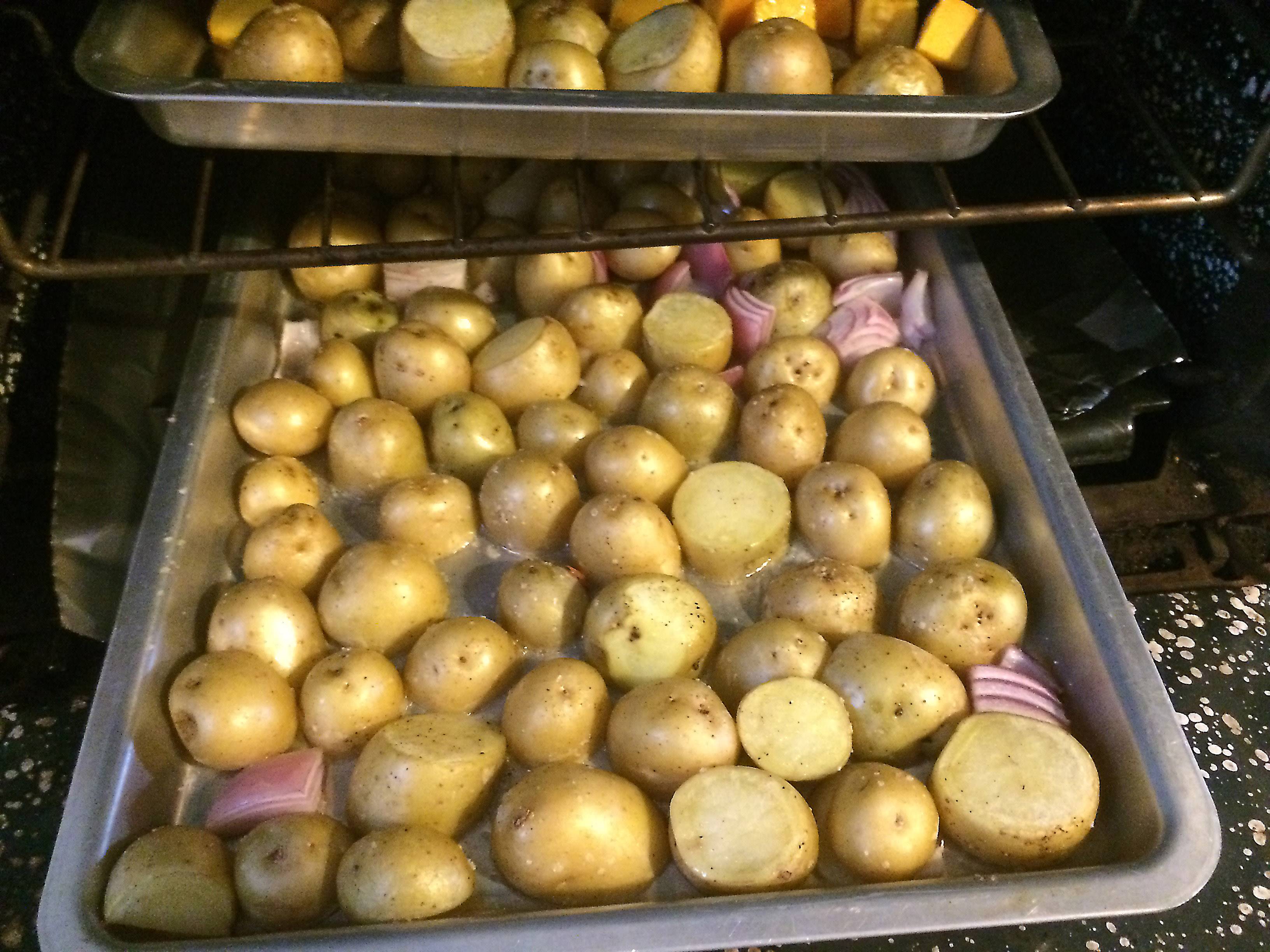
Theory
I know, I know: you just want to cook dinner. Who cares about theory? We do, and here's why: there are plenty of places out there to get recipes, but not that many places give you the reasons why you're doing things. That's the craft of cooking, rather than just cooking by numbers. Learn the theory, and you can apply it anywhere.
So what's the big idea? Root vegetables are dense and hold a fair amount of water. Get rid of that water, and their flavors will be concentrated. That's it.
So, the best way to quickly eliminate water is to use lots of high, dry heat, like in your oven. Other methods will work -- see the Cooking Options section, below -- but the oven is easy. Steaming, boiling, and microwaving are all bad. Don't use them for this technique.
Other, minor points:
• Kosher salt is good in this recipe for managing the amount of salt you're using. It's easy to sprinkle. Table salt is hard to sprinkle evenly, and you'll end up with pockets of too-salty and not-salty-enough vegetables. It's also easy to over-salt with table salt.
• Freshly ground pepper is a must. Its flavor is completely different from, and much better than, a tin of pre-ground pepper. Buy a pepper grinder and use it.
• Feel free to add small-leafed fresh herbs like rosemary, tarragon, or crushed garlic if you like. Leafier herbs will burn. Dried herbs won't do much in this recipe because there isn't water and/or oil to extract and disperse their flavors (which have been concentrated by drying... see a pattern?).
• Cook to texture, not to time. This is a Big Theory item, frankly, but I'll sneak it in here. When it hits the texture you want, it's done. Don't worry about how long it's been in there. That's also why we cut the pieces all to roughly the same size: they'll cook at roughly the same rates. As you work with this recipe, you may find that some vegetables cook more quickly than others, and you can compensate for that by making bigger pieces or keeping them separately to pull out after a shorter cooking period.
So what's the big idea? Root vegetables are dense and hold a fair amount of water. Get rid of that water, and their flavors will be concentrated. That's it.
So, the best way to quickly eliminate water is to use lots of high, dry heat, like in your oven. Other methods will work -- see the Cooking Options section, below -- but the oven is easy. Steaming, boiling, and microwaving are all bad. Don't use them for this technique.
Other, minor points:
• Kosher salt is good in this recipe for managing the amount of salt you're using. It's easy to sprinkle. Table salt is hard to sprinkle evenly, and you'll end up with pockets of too-salty and not-salty-enough vegetables. It's also easy to over-salt with table salt.
• Freshly ground pepper is a must. Its flavor is completely different from, and much better than, a tin of pre-ground pepper. Buy a pepper grinder and use it.
• Feel free to add small-leafed fresh herbs like rosemary, tarragon, or crushed garlic if you like. Leafier herbs will burn. Dried herbs won't do much in this recipe because there isn't water and/or oil to extract and disperse their flavors (which have been concentrated by drying... see a pattern?).
• Cook to texture, not to time. This is a Big Theory item, frankly, but I'll sneak it in here. When it hits the texture you want, it's done. Don't worry about how long it's been in there. That's also why we cut the pieces all to roughly the same size: they'll cook at roughly the same rates. As you work with this recipe, you may find that some vegetables cook more quickly than others, and you can compensate for that by making bigger pieces or keeping them separately to pull out after a shorter cooking period.
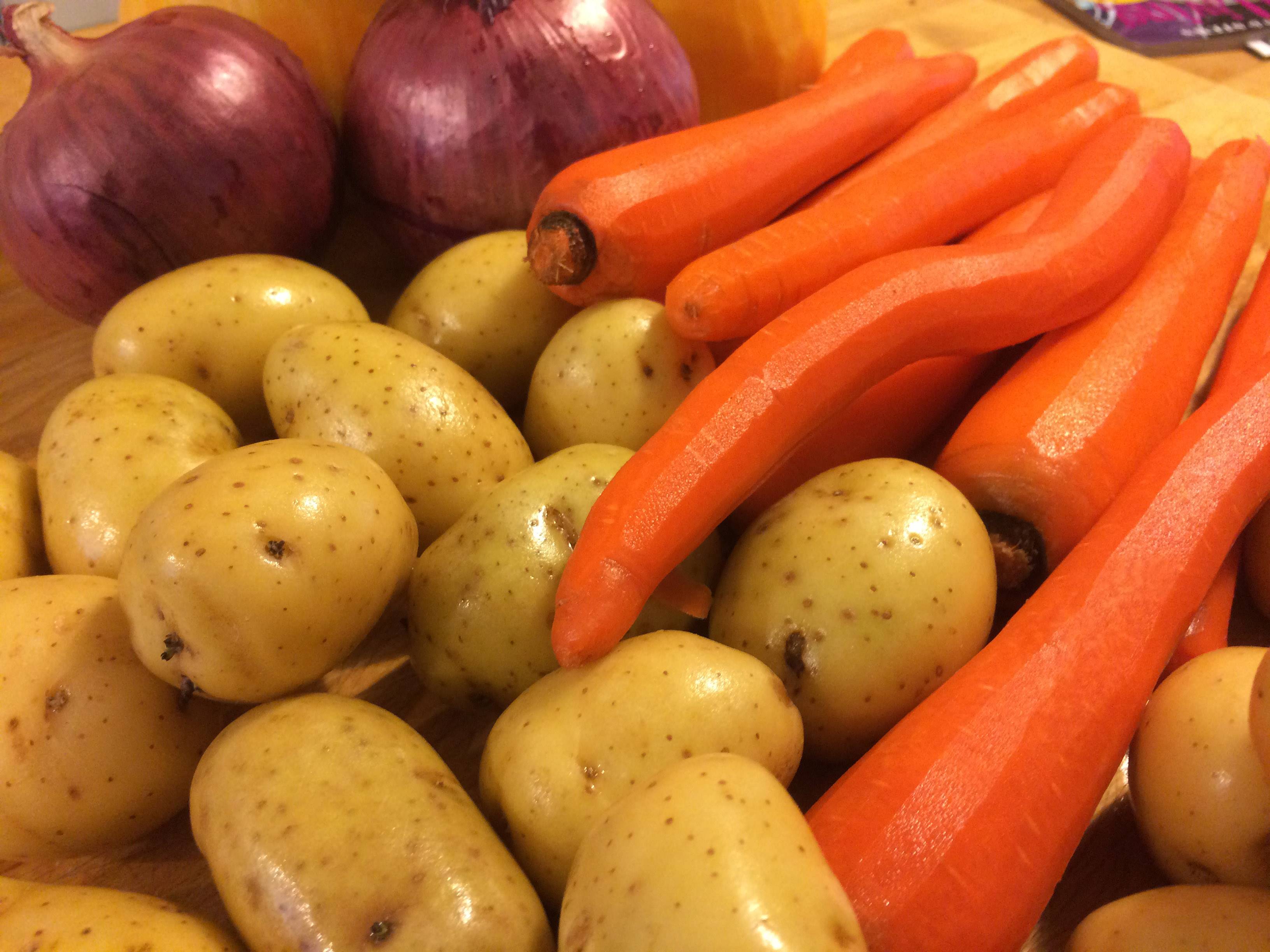
Ingredients
Any root vegetable will work well. Frankly, just about any vegetable, period, will work. But a good selection might include carrots, potatoes, parsnips, beets, sweet potatoes, squash, onions, or brussels sprouts. Avoid leafy vegetables (they'll burn in the time it takes to roast these and/or disintegrate into nothingness) or tomatoes (they're great roasted or grilled, but they emit too much water to be mixed with other stuff).
The quantity is up to you: as much or as little as you want. But don't buy more than you can put in your oven on cookie sheets in one layer. More on that in a bit.
Other than the vegetables themselves, you'll need kosher salt, freshly ground pepper, and oil of some kind - light olive oil, canola, or another light oil will work. Don't waste your nice extra virgin olive oil, despite what the television personalities tell you; the cooking process will destroy all of its delicate taste.
The quantity is up to you: as much or as little as you want. But don't buy more than you can put in your oven on cookie sheets in one layer. More on that in a bit.
Other than the vegetables themselves, you'll need kosher salt, freshly ground pepper, and oil of some kind - light olive oil, canola, or another light oil will work. Don't waste your nice extra virgin olive oil, despite what the television personalities tell you; the cooking process will destroy all of its delicate taste.

Prep
Wash and trim all of your vegetables, then chop into cubes roughly 3/4 inch on each side. You won't be able to manage that perfectly because vegetables aren't cubes to start with. That's fine. Just get close. If some of the pieces are longer than that -- carrots, for example -- that's fine too. This isn't rocket science. As long as everything is in the ballpark, it will work out.
Once you're done with the chopping, spread the pieces out on your cookie sheets in a single layer. Don't pile them up, or you'll get soggy, steamed vegetables rather than roasted vegetables. The idea is to use high, dry heat to remove moisture from the vegetables while cooking to concentrate flavor.
Sprinkle oil over the vegetables. For an entire cookie sheet, you'll need perhaps a quarter cup of oil or a bit less. You want a thin coat of oil on all the surfaces of the vegetables, but no more. Sprinkle kosher salt (for a full cookie sheet, a tablespoon or so) and ground pepper (a quarter to half teaspoon) over them as well. Mix the vegetables, salt, pepper, and oil up with your hands to coat everything evenly, then spread out into one layer again.
Once you're done with the chopping, spread the pieces out on your cookie sheets in a single layer. Don't pile them up, or you'll get soggy, steamed vegetables rather than roasted vegetables. The idea is to use high, dry heat to remove moisture from the vegetables while cooking to concentrate flavor.
Sprinkle oil over the vegetables. For an entire cookie sheet, you'll need perhaps a quarter cup of oil or a bit less. You want a thin coat of oil on all the surfaces of the vegetables, but no more. Sprinkle kosher salt (for a full cookie sheet, a tablespoon or so) and ground pepper (a quarter to half teaspoon) over them as well. Mix the vegetables, salt, pepper, and oil up with your hands to coat everything evenly, then spread out into one layer again.
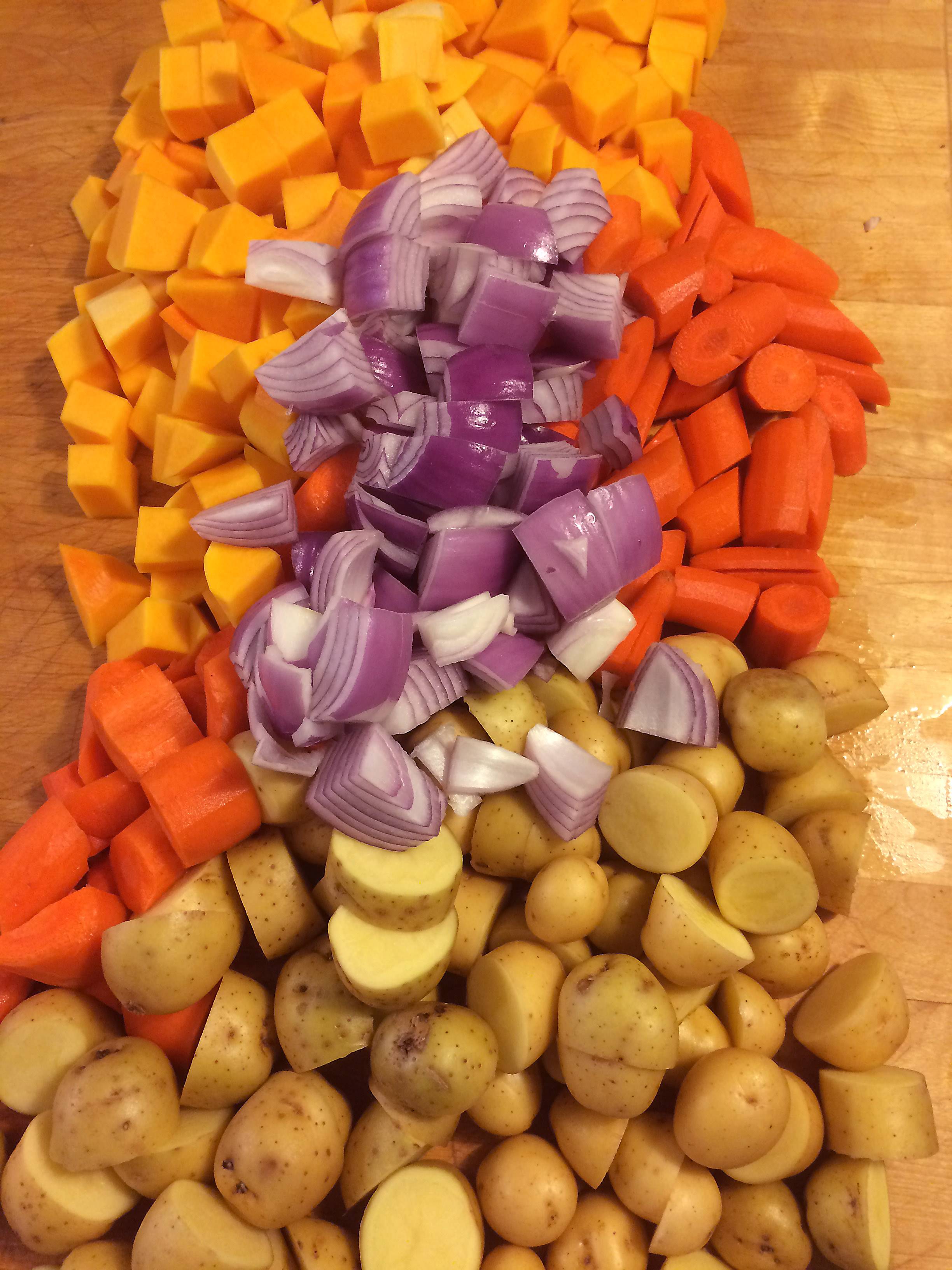
Cooking Options
You've got a couple of choices here for cooking. For all of these options, the real key is to test whether the vegetables are done by poking them with a fork. If the fork goes in easily, you're done. If not, keep going. The times given below are guides, but actual cooking time will vary depending on your vegetables, cutting technique, and heat levels.
Roasting: this is the lowest-maintenance option. Throw them in the oven at 450 degrees for 45 minutes or so, and you're done. Mix them up about halfway through if you like, but it's not critical.
Grill-roasting: You can roast on a gas grill on a cookie sheet, but you can't light the burner(s) directly under the cookie sheet -- that will torch your cookie sheet and vegetables in short order. Instead, set your grill up for two-zone cooking, put the cookie sheet on the cold side, and you're good to go. If your grill doesn't let you do that kind of setup, you'll have to use another option. Turn the vegetables every ten minutes, or more often if it looks like they're getting done quickly. Depending on your grill, this can take anywhere from 30 to 60 minutes.
Grill: Vegetables prepped this way do great in a grill basket. Jack the heat all the way up and turn the veggies every few minutes. Depending on your grill, this might take 10-30 minutes.
Pan sauté: Put a bit more oil in a sauté pan, heat on medium heat until the oil is lightly shimmering, and then add your vegetables in a single layer. Turn every few minutes. This will take 20-30 minutes or so.
Roasting: this is the lowest-maintenance option. Throw them in the oven at 450 degrees for 45 minutes or so, and you're done. Mix them up about halfway through if you like, but it's not critical.
Grill-roasting: You can roast on a gas grill on a cookie sheet, but you can't light the burner(s) directly under the cookie sheet -- that will torch your cookie sheet and vegetables in short order. Instead, set your grill up for two-zone cooking, put the cookie sheet on the cold side, and you're good to go. If your grill doesn't let you do that kind of setup, you'll have to use another option. Turn the vegetables every ten minutes, or more often if it looks like they're getting done quickly. Depending on your grill, this can take anywhere from 30 to 60 minutes.
Grill: Vegetables prepped this way do great in a grill basket. Jack the heat all the way up and turn the veggies every few minutes. Depending on your grill, this might take 10-30 minutes.
Pan sauté: Put a bit more oil in a sauté pan, heat on medium heat until the oil is lightly shimmering, and then add your vegetables in a single layer. Turn every few minutes. This will take 20-30 minutes or so.
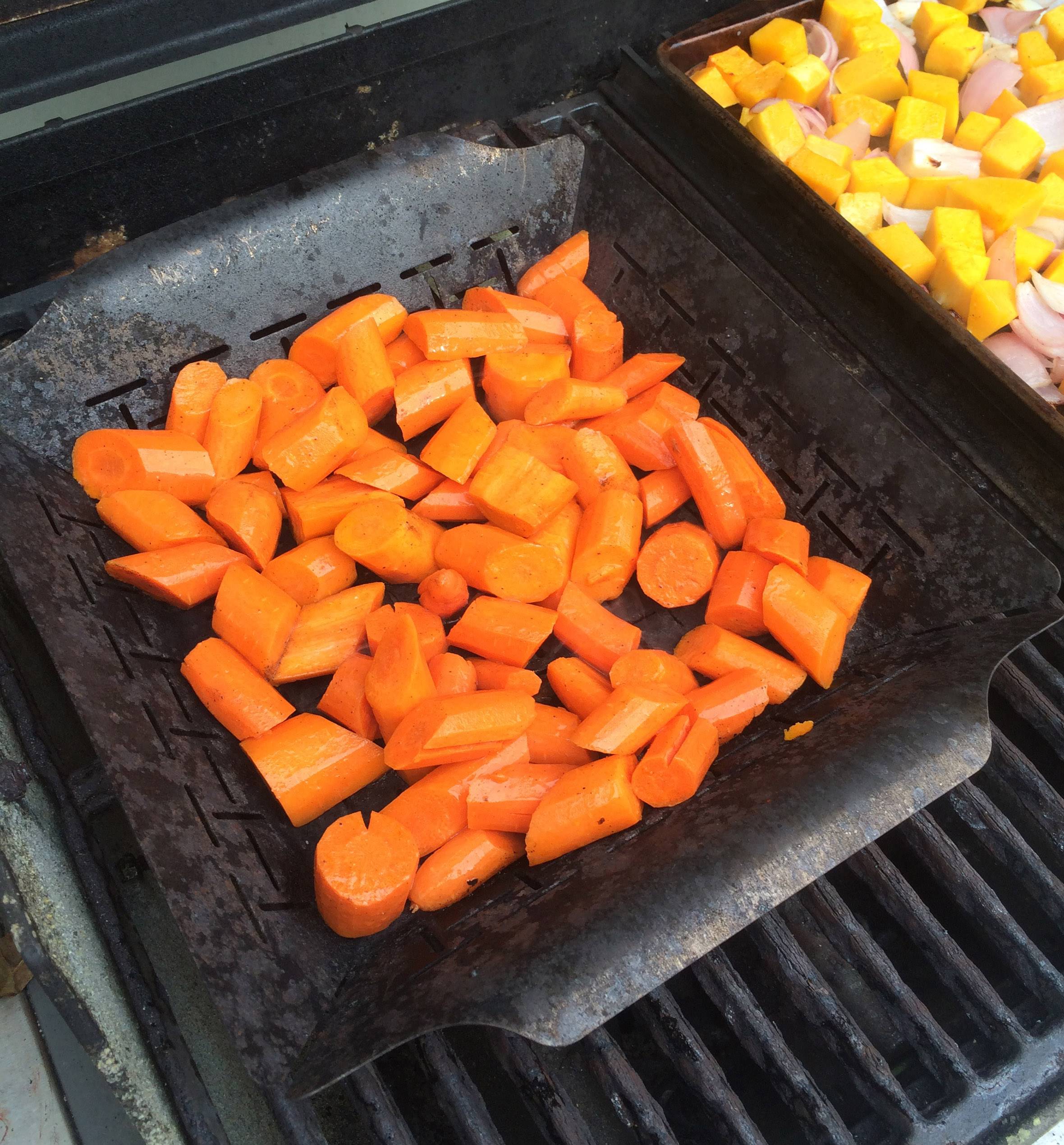

Done
That's it. Serve and enjoy. These go especially well with roasted chicken, grilled pork, or on top of some basmati rice with an Indian curry sauce.
